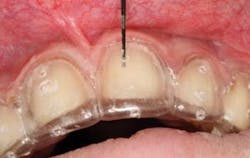Revisiting the reline procedure may keep you out of trouble Part 2
Joseph J. Massad, DDS
Welcome back! This month’s tip involves revisiting the reline procedure for both removable prosthodontics and implant overdenture procedures. In last month’s column, I listed six complaints by dentists, technicians, and patients relating to unsatisfactory results in laboratory processed relines. This month’s tip addresses a clinical protocol developed to eliminate patient complaints such as the lack of stability and retention, as well as esthetic discrepancies after the reline is delivered. It will also eliminate the dentist’s blaming the lab for these problems while the prosthetic technicians claim that everything fit the model.
When we all work together, we can conquer most anything before us. The premise of the protocol is that relining should be performed for its intended purpose, i.e., to resurface the intaglio (internal surface) of a removable prosthesis to obtain an intimate fit for purposes of tissue retention. Also, relines fill voids in the intaglio surface where bone changes or resorption has occurred. The reline procedure is not intended to alter reduced vertical dimension due to tooth wear and/or other factors.
Esthetics, stability, and retention may be adversely affected if an increase in the patient’s existing occlusal vertical dimension exceeds 2mm or more of thickening of the denture base when relining the intaglio surfaces of a complete denture or implant overdenture.
Figures 1 through 6 go through a reline protocol that maintains the existing occlusal relationship and provides a guide to eliminate rotational or lateral displacement while maintaining the desired vertical dimension.
Figures 1a and 1b show measuring the existing OVD while the patient closed at maximum tooth contact.
FIG. 1a, 1b
Figure 2a demonstrates making an occlusal index with a PVS material, and Figure 2b shows verifying dimension with dividers. Figure 2c demonstrates the accuracy of the index by observing show areas through the polymerized bite registration.
FIG. 2a, 2b
Figure 3a displays coating the intaglio of the denture with a dye called reline ink to act as an indicator for an even relief of the existing acrylic surface. Figure 3b demonstrates removing the internal surface with an acrylic bur. The ink penetrates approximately 1mm, and all the ink must be removed to assure that the entire intaglio surface has been cut. This procedure allows adequate space for the necessary impression material and eliminates opening the vertical with too thick a layer of material.
FIG. 3a, 3b
Figure 4a displays three mounds of rigid PVS impression material to act as tissue stops to orient the lower prosthesis to the upper, and allow the space needed to make the final wash impression. Figure 3b shows the polymerized PVS stops trimmed. These stops will allow the prosthesis to be reinserted to the intended orientation.
FIG. 4a, 4b
Figure 5a shows the PVS wash material placed with a light viscosity in the soft tissue area, and a heavy viscosity placed onto the border in the mylohyoid and retromylohyoid areas to make the final wash impression. Figure 5b demonstrates the detail of the definitive final reline impression.
FIG. 5a, 5b
Figure 6a demonstrates how the bite registration was utilized to assure the existing occlusal contacts were maintained during the impression-making procedure. This registration was essential to maintain the occlusal relationship and also assisted the patient in closing exactly to the existing bite. Figure 6b shows the upper and lower denture out of the mouth in the desired orientation while maintaining the vertical dimension within the acceptable range.
FIG. 6a, 6b
Following a systematic approach and using a protocol checklist will help us keep focused while doing procedures such as this.
I hope this tip has helped you, and again, I hope my pleasure in dentistry will be yours.
See you next month.
Dr. Joseph Massad may be reached by phone at (918) 749-5600 or by email at [email protected].
To see Dr. Massad’s video tips, visit www.DentalLibrary.com
Past DE Issues






